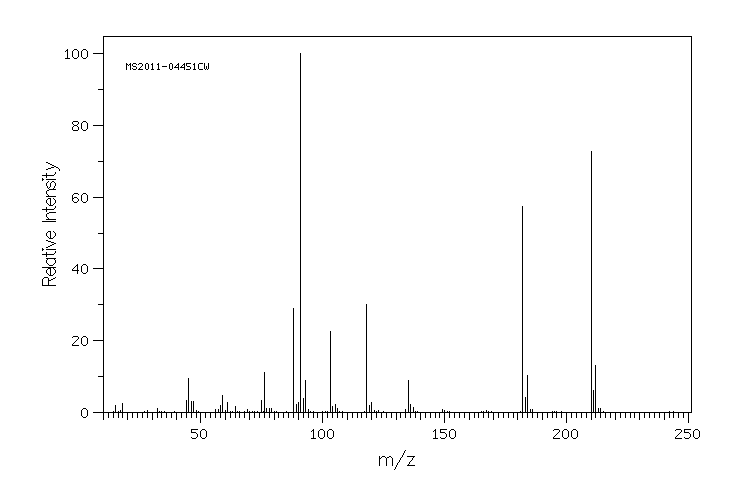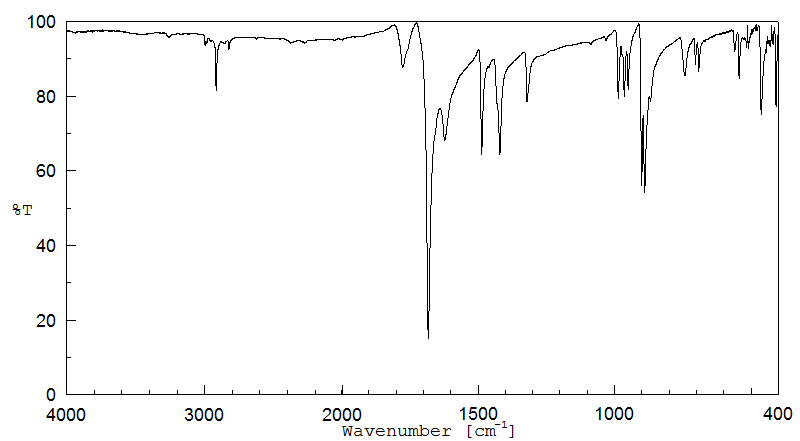4,5-双(甲硫代)-1,3-二硫杂环戊烯-2-酮 | 61485-46-9
中文名称
4,5-双(甲硫代)-1,3-二硫杂环戊烯-2-酮
中文别名
4,5-双(甲硫代)-1,3-二硫醇-2-酮;4,5-双(甲基硫代)-1,3-二硫杂环戊二烯-2-1
英文名称
4,5-bis(methylthio)-1,3-dithiol-2-one
英文别名
4,5-bis(methylsulfanyl)-1,3-dithiol-2-one
CAS
61485-46-9
化学式
C5H6OS4
mdl
MFCD00137889
分子量
210.366
InChiKey
ZXNVEXYJVODARP-UHFFFAOYSA-N
BEILSTEIN
——
EINECS
——
-
物化性质
-
计算性质
-
ADMET
-
安全信息
-
SDS
-
制备方法与用途
-
上下游信息
-
文献信息
-
表征谱图
-
同类化合物
-
相关功能分类
-
相关结构分类
物化性质
-
熔点:56-60 °C(lit.)
-
沸点:304.8±52.0 °C(Predicted)
-
密度:1.50±0.1 g/cm3(Predicted)
-
稳定性/保质期:
避免接触氧化物
计算性质
-
辛醇/水分配系数(LogP):2.8
-
重原子数:10
-
可旋转键数:2
-
环数:1.0
-
sp3杂化的碳原子比例:0.4
-
拓扑面积:118
-
氢给体数:0
-
氢受体数:5
安全信息
-
WGK Germany:3
-
海关编码:2930909090
SDS
1.1 产品标识符
: 4,5-双(甲硫代)-1,3-二硫杂环戊烯-2-酮
产品名称
1.2 鉴别的其他方法
无数据资料
1.3 有关的确定了的物质或混合物的用途和建议不适合的用途
仅供科研用途,不作为药物、家庭备用药或其它用途。
模块 2. 危险性概述
2.1 GHS分类
根据化学品全球统一分类与标签制度(GHS)的规定,不是危险物质或混合物。
当心 - 物质尚未完全测试。
2.3 其它危害物 - 无
模块 3. 成分/组成信息
3.1 物 质
: C5H6OS4
分子式
: 210.36 g/mol
分子量
无
模块 4. 急救措施
4.1 必要的急救措施描述
吸入
如果吸入,请将患者移到新鲜空气处。 如果停止了呼吸,给于人工呼吸。
皮肤接触
用肥皂和大量的水冲洗。
眼睛接触
用水冲洗眼睛作为预防措施。
食入
切勿给失去知觉者从嘴里喂食任何东西。 用水漱口。
4.2 主要症状和影响,急性和迟发效应
4.3 及时的医疗处理和所需的特殊处理的说明和指示
无数据资料
模块 5. 消防措施
5.1 灭火介质
灭火方法及灭火剂
用水雾,耐醇泡沫,干粉或二氧化碳灭火。
5.2 源于此物质或混合物的特别的危害
碳氧化物, 硫氧化物
5.3 给消防员的建议
如必要的话,戴自给式呼吸器去救火。
5.4 进一步信息
无数据资料
模块 6. 泄露应急处理
6.1 人员的预防,防护设备和紧急处理程序
防止粉尘的生成。 防止吸入蒸汽、气雾或气体。
6.2 环境保护措施
不要让产物进入下水道。
6.3 抑制和清除溢出物的方法和材料
扫掉和铲掉。 存放进适当的闭口容器中待处理。
6.4 参考其他部分
丢弃处理请参阅第13节。
模块 7. 操作处置与储存
7.1 安全操作的注意事项
在有粉尘生成的地方,提供合适的排风设备。一般性的防火保护措施。
7.2 安全储存的条件,包括任何不兼容性
贮存在阴凉处。 容器保持紧闭,储存在干燥通风处。
7.3 特定用途
无数据资料
模块 8. 接触控制和个体防护
8.1 容许浓度
最高容许浓度
没有已知的国家规定的暴露极限。
8.2 暴露控制
适当的技术控制
常规的工业卫生操作。
个体防护设备
眼/面保护
请使用经官方标准如NIOSH (美国) 或 EN 166(欧盟) 检测与批准的设备防护眼部。
皮肤保护
戴手套取 手套在使用前必须受检查。
请使用合适的方法脱除手套(不要接触手套外部表面),避免任何皮肤部位接触此产品.
使用后请将被污染过的手套根据相关法律法规和有效的实验室规章程序谨慎处理. 请清洗并吹干双手
所选择的保护手套必须符合EU的89/686/EEC规定和从它衍生出来的EN 376标准。
身体保护
根据危险物质的类型,浓度和量,以及特定的工作场所来选择人体保护措施。,
防护设备的类型必须根据特定工作场所中的危险物的浓度和含量来选择。
呼吸系统防护
不需要保护呼吸。如需防护粉尘损害,请使用N95型(US)或P1型(EN 143)防尘面具。
呼吸器使用经过测试并通过政府标准如NIOSH(US)或CEN(EU)的呼吸器和零件。
模块 9. 理化特性
9.1 基本的理化特性的信息
a) 外观与性状
形状: 粉末
颜色: 黄色
b) 气味
无数据资料
c) 气味阈值
无数据资料
d) pH值
无数据资料
e) 熔点/凝固点
熔点/凝固点: 56 - 60 °C - lit.
f) 起始沸点和沸程
无数据资料
g) 闪点
无数据资料
h) 蒸发速率
无数据资料
i) 易燃性(固体,气体)
无数据资料
j) 高的/低的燃烧性或爆炸性限度 无数据资料
k) 蒸汽压
无数据资料
l) 蒸汽密度
无数据资料
m) 相对密度
无数据资料
n) 水溶性
无数据资料
o) n-辛醇/水分配系数
无数据资料
p) 自燃温度
无数据资料
q) 分解温度
无数据资料
r) 粘度
无数据资料
模块 10. 稳定性和反应活性
10.1 反应性
无数据资料
10.2 稳定性
无数据资料
10.3 危险反应的可能性
无数据资料
10.4 应避免的条件
无数据资料
10.5 不兼容的材料
强氧化剂
10.6 危险的分解产物
其它分解产物 - 无数据资料
模块 11. 毒理学资料
11.1 毒理学影响的信息
急性毒性
无数据资料
皮肤刺激或腐蚀
无数据资料
眼睛刺激或腐蚀
无数据资料
呼吸道或皮肤过敏
无数据资料
生殖细胞突变性
无数据资料
致癌性
IARC:
此产品中没有大于或等于 0。1%含量的组分被 IARC鉴别为可能的或肯定的人类致癌物。
生殖毒性
无数据资料
特异性靶器官系统毒性(一次接触)
无数据资料
特异性靶器官系统毒性(反复接触)
无数据资料
吸入危险
无数据资料
潜在的健康影响
吸入 吸入可能有害。 可能引起呼吸道刺激。
摄入 如服入是有害的。
皮肤 如果通过皮肤吸收可能是有害的。 可能引起皮肤刺激。
眼睛 可能引起眼睛刺激。
附加说明
化学物质毒性作用登记: 无数据资料
模块 12. 生态学资料
12.1 生态毒性
无数据资料
12.2 持久存留性和降解性
无数据资料
12.3 潜在的生物蓄积性
无数据资料
12.4 土壤中的迁移性
无数据资料
12.5 PBT 和 vPvB的结果评价
无数据资料
12.6 其它不利的影响
无数据资料
模块 13. 废弃处置
13.1 废物处理方法
产品
将剩余的和未回收的溶液交给处理公司。
受污染的容器和包装
作为未用过的产品弃置。
模块 14. 运输信息
14.1 联合国危险货物编号
欧洲陆运危规: - 国际海运危规: - 国际空运危规: -
14.2 联合国(UN)规定的名称
欧洲陆运危规: 非危险货物
国际海运危规: 非危险货物
国际空运危规: 非危险货物
14.3 运输危险类别
欧洲陆运危规: - 国际海运危规: - 国际空运危规: -
14.4 包裹组
欧洲陆运危规: - 国际海运危规: - 国际空运危规: -
14.5 环境危险
欧洲陆运危规: 否 国际海运危规 海运污染物: 否 国际空运危规: 否
14.6 对使用者的特别提醒
无数据资料
模块 15 - 法规信息
N/A
模块16 - 其他信息
N/A
: 4,5-双(甲硫代)-1,3-二硫杂环戊烯-2-酮
产品名称
1.2 鉴别的其他方法
无数据资料
1.3 有关的确定了的物质或混合物的用途和建议不适合的用途
仅供科研用途,不作为药物、家庭备用药或其它用途。
模块 2. 危险性概述
2.1 GHS分类
根据化学品全球统一分类与标签制度(GHS)的规定,不是危险物质或混合物。
当心 - 物质尚未完全测试。
2.3 其它危害物 - 无
模块 3. 成分/组成信息
3.1 物 质
: C5H6OS4
分子式
: 210.36 g/mol
分子量
无
模块 4. 急救措施
4.1 必要的急救措施描述
吸入
如果吸入,请将患者移到新鲜空气处。 如果停止了呼吸,给于人工呼吸。
皮肤接触
用肥皂和大量的水冲洗。
眼睛接触
用水冲洗眼睛作为预防措施。
食入
切勿给失去知觉者从嘴里喂食任何东西。 用水漱口。
4.2 主要症状和影响,急性和迟发效应
4.3 及时的医疗处理和所需的特殊处理的说明和指示
无数据资料
模块 5. 消防措施
5.1 灭火介质
灭火方法及灭火剂
用水雾,耐醇泡沫,干粉或二氧化碳灭火。
5.2 源于此物质或混合物的特别的危害
碳氧化物, 硫氧化物
5.3 给消防员的建议
如必要的话,戴自给式呼吸器去救火。
5.4 进一步信息
无数据资料
模块 6. 泄露应急处理
6.1 人员的预防,防护设备和紧急处理程序
防止粉尘的生成。 防止吸入蒸汽、气雾或气体。
6.2 环境保护措施
不要让产物进入下水道。
6.3 抑制和清除溢出物的方法和材料
扫掉和铲掉。 存放进适当的闭口容器中待处理。
6.4 参考其他部分
丢弃处理请参阅第13节。
模块 7. 操作处置与储存
7.1 安全操作的注意事项
在有粉尘生成的地方,提供合适的排风设备。一般性的防火保护措施。
7.2 安全储存的条件,包括任何不兼容性
贮存在阴凉处。 容器保持紧闭,储存在干燥通风处。
7.3 特定用途
无数据资料
模块 8. 接触控制和个体防护
8.1 容许浓度
最高容许浓度
没有已知的国家规定的暴露极限。
8.2 暴露控制
适当的技术控制
常规的工业卫生操作。
个体防护设备
眼/面保护
请使用经官方标准如NIOSH (美国) 或 EN 166(欧盟) 检测与批准的设备防护眼部。
皮肤保护
戴手套取 手套在使用前必须受检查。
请使用合适的方法脱除手套(不要接触手套外部表面),避免任何皮肤部位接触此产品.
使用后请将被污染过的手套根据相关法律法规和有效的实验室规章程序谨慎处理. 请清洗并吹干双手
所选择的保护手套必须符合EU的89/686/EEC规定和从它衍生出来的EN 376标准。
身体保护
根据危险物质的类型,浓度和量,以及特定的工作场所来选择人体保护措施。,
防护设备的类型必须根据特定工作场所中的危险物的浓度和含量来选择。
呼吸系统防护
不需要保护呼吸。如需防护粉尘损害,请使用N95型(US)或P1型(EN 143)防尘面具。
呼吸器使用经过测试并通过政府标准如NIOSH(US)或CEN(EU)的呼吸器和零件。
模块 9. 理化特性
9.1 基本的理化特性的信息
a) 外观与性状
形状: 粉末
颜色: 黄色
b) 气味
无数据资料
c) 气味阈值
无数据资料
d) pH值
无数据资料
e) 熔点/凝固点
熔点/凝固点: 56 - 60 °C - lit.
f) 起始沸点和沸程
无数据资料
g) 闪点
无数据资料
h) 蒸发速率
无数据资料
i) 易燃性(固体,气体)
无数据资料
j) 高的/低的燃烧性或爆炸性限度 无数据资料
k) 蒸汽压
无数据资料
l) 蒸汽密度
无数据资料
m) 相对密度
无数据资料
n) 水溶性
无数据资料
o) n-辛醇/水分配系数
无数据资料
p) 自燃温度
无数据资料
q) 分解温度
无数据资料
r) 粘度
无数据资料
模块 10. 稳定性和反应活性
10.1 反应性
无数据资料
10.2 稳定性
无数据资料
10.3 危险反应的可能性
无数据资料
10.4 应避免的条件
无数据资料
10.5 不兼容的材料
强氧化剂
10.6 危险的分解产物
其它分解产物 - 无数据资料
模块 11. 毒理学资料
11.1 毒理学影响的信息
急性毒性
无数据资料
皮肤刺激或腐蚀
无数据资料
眼睛刺激或腐蚀
无数据资料
呼吸道或皮肤过敏
无数据资料
生殖细胞突变性
无数据资料
致癌性
IARC:
此产品中没有大于或等于 0。1%含量的组分被 IARC鉴别为可能的或肯定的人类致癌物。
生殖毒性
无数据资料
特异性靶器官系统毒性(一次接触)
无数据资料
特异性靶器官系统毒性(反复接触)
无数据资料
吸入危险
无数据资料
潜在的健康影响
吸入 吸入可能有害。 可能引起呼吸道刺激。
摄入 如服入是有害的。
皮肤 如果通过皮肤吸收可能是有害的。 可能引起皮肤刺激。
眼睛 可能引起眼睛刺激。
附加说明
化学物质毒性作用登记: 无数据资料
模块 12. 生态学资料
12.1 生态毒性
无数据资料
12.2 持久存留性和降解性
无数据资料
12.3 潜在的生物蓄积性
无数据资料
12.4 土壤中的迁移性
无数据资料
12.5 PBT 和 vPvB的结果评价
无数据资料
12.6 其它不利的影响
无数据资料
模块 13. 废弃处置
13.1 废物处理方法
产品
将剩余的和未回收的溶液交给处理公司。
受污染的容器和包装
作为未用过的产品弃置。
模块 14. 运输信息
14.1 联合国危险货物编号
欧洲陆运危规: - 国际海运危规: - 国际空运危规: -
14.2 联合国(UN)规定的名称
欧洲陆运危规: 非危险货物
国际海运危规: 非危险货物
国际空运危规: 非危险货物
14.3 运输危险类别
欧洲陆运危规: - 国际海运危规: - 国际空运危规: -
14.4 包裹组
欧洲陆运危规: - 国际海运危规: - 国际空运危规: -
14.5 环境危险
欧洲陆运危规: 否 国际海运危规 海运污染物: 否 国际空运危规: 否
14.6 对使用者的特别提醒
无数据资料
模块 15 - 法规信息
N/A
模块16 - 其他信息
N/A
上下游信息
-
上游原料
中文名称 英文名称 CAS号 化学式 分子量 4,5-双(甲硫代)-1,3-二硫杂环戊烯-2-硫酮 4,5-bis(methylthio)-1,3-dithiole-2-thione 49638-64-4 C5H6S5 226.433
反应信息
-
作为反应物:描述:4,5-双(甲硫代)-1,3-二硫杂环戊烯-2-酮 在 sodium ethanolate 、 4,5-bis(p-acetoxybenzylsulfanyl)-1,3-dithiol-2-one 、 亚磷酸三乙酯 作用下, 以 甲苯 为溶剂, 反应 24.5h, 生成 (四甲基硫)四硫富瓦烯参考文献:名称:Gemmell, Colin; Janairo, Gerardo C.; Kilburn, Jeremy D., Journal of the Chemical Society. Perkin transactions I, 1994, # 19, p. 2715 - 2720摘要:DOI:
-
作为产物:描述:4,5-Bis(methylthio)-2-morpholino-1,3-dithiolium-bromid 在 硫化氢 、 mercury(II) diacetate 、 sodium perchlorate 作用下, 以 吡啶 、 氯仿 、 水 、 溶剂黄146 为溶剂, 反应 11.0h, 生成 4,5-双(甲硫代)-1,3-二硫杂环戊烯-2-酮参考文献:名称:Hartke, Klaus; Kissel, Thomas; Quante, Josef, Chemische Berichte, 1980, vol. 113, # 5, p. 1898 - 1906摘要:DOI:
文献信息
-
Polymer-Supported Diaryl Selenoxide and Telluroxide as Mild and Selective Oxidizing Agents作者:Nan Xing Hu、Yoshio Aso、Tetsuo Otsubo、Fumio OguraDOI:10.1246/bcsj.59.879日期:1986.3Polystyrene-bound diaryl selenoxide and telluroxide have been prepared, which behaved as mild oxidizing agents for thiols to disulfides, phosphines to phosphine oxides, hydroquinone and catechol to p- and o-benzoquinones, and thioketones to oxo compounds. The telluroxide completed these reactions in shorter periods or under milder conditions than the selenoxide. In addition, they effected novel solvent-dependent
-
Redox-active proligands from the direct connection of 1,3-dithiol-2-one to tetrathiafulvalene (TTF): syntheses, characterizations and metal complexation作者:Franck Camerel、Olivier Jeannin、Gilles Yzambart、Bruno Fabre、Dominique Lorcy、Marc FourmiguéDOI:10.1039/c3nj41097h日期:——In the search for novel tetrathiafulvalene-substituted dithiolene ligands, two tetrathiafulvalene (TTF) molecules directly connected to 1,3-dithiol-2-one fragments have been synthesized and characterized by single crystal X-ray diffraction, electrochemical and spectroscopic analyses. TTF1 was obtained, in moderate yield, by the cross-coupling of 4,5-bis(methylthio)-1,3-dithiole-2-one with 4,4′-bis(1,3-dithiole-2-one) in triethylphosphite, whereas for TTF2, the 1,3-dithiol-2-one fragment was introduced, in high yield, by an original reaction of the alkyne group of an ethynyl TTF (Me3TTF–CCH) with xanthogen in the presence of a radical initiator. Opening of the 1,3-dithiol-2-one fragments with sodium methanolate leads to the formation of two new 1,2-dithiolate ligands functionalized with redox-active TTF moieties, which can efficiently coordinate metals. As an illustration, two original heteroleptic bis(cyclopentadienyl)dithiolene titanium complexes were isolated and characterized.在寻找新型四硫富瓦烯取代二硫烯配体的过程中,我们合成了两种直接连接四硫富瓦烯(TTF)分子与1,3-二硫杂环戊烯-2-酮片段的化合物,并通过单晶X射线衍射、电化学和光谱分析进行了表征。TTF1是通过4,5-双(甲硫基)-1,3-二硫杂环戊烯-2-酮与4,4′-双(1,3-二硫杂环戊烯-2-酮)在三乙基亚磷酸酯中的交叉偶联反应制备的,产率中等;而TTF2则是通过一种原始的反应,在自由基引发剂存在下,将乙炔基TTF(Me3TTF–CCH)的炔基与黄原酸酯反应引入1,3-二硫杂环戊烯-2-酮片段,产率较高。用甲醇钠打开1,3-二硫杂环戊烯-2-酮片段,形成了两种新的含氧化还原活性TTF基团的1,2-二硫醇配体,这些配体能够有效地与金属配位。作为示例,我们分离并表征了两种新颖的杂配体双(环戊二烯基)二硫烯钛配合物。
-
Aryl ester dendrimers incorporating tetrathiafulvalene units: convergent synthesis, electrochemistry and charge-transfer properties作者:Wayne Devonport、Martin R. Bryce、Gary J. Marshallsay、Adrian J. Moore、Leonid M. GoldenbergDOI:10.1039/a800225h日期:——The convergent synthesis of a range of aryl ester dendrimers with peripheral tetrathiafulvalene (TTF) units is reported.4-(Hydroxymethyl)-TTF and 4,5-(2-hydroxymethylpropane-1,3-diyldithio)-TTF have been used as the starting TTF reagents. The core reagents are benzene-1,3,5-tricarbonyl trichloride, terephthaloyl chloride, biphenyl-4-4′-dicarbonyl chloride and 4,4′-oxybis(benzenecarbonyl chloride). Dendrimers comprising up to 12 TTF units have been characterised by elemental analysis, plasma desorption mass spectrometry,1H NMR spectroscopy and solution electrochemistry. Cyclic voltammetry (CV) and ultra microelectrode CV studies show that the TTF dendrimers display nearly ideal redox behaviour for the TTF system with no significant interaction between the TTF units. Thin layer cyclic voltammetric studies show that all the TTF units of these systems undergo two, single-electron oxidations. The dendrimers form charge-transfer complexes upon reaction with iodine in solution. Intermolecular interactions of the TTF radical cations are observed in the UV–VIS spectra of some of the oxidised derivatives.据报道,一系列具有外围四硫富瓦烯(TTF)单元的芳基酯树枝状大分子的聚合合成。采用4-(羟甲基)-TTF和4,5-(2-羟甲基丙烷-1,3-二亚磺基)-TTF作为起始TTF试剂。核心试剂为苯-1,3,5-三羰基三氯化物、对苯二甲酰氯、联苯-4-4'-二羰基氯和4,4'-氧双(苯甲酰氯)。通过元素分析、等离子体解吸质谱、1H NMR波谱学和溶液电化学对包含多达12个TTF单元的树枝状大分子进行了表征。循环伏安法(CV)和超微电极CV研究表明,TTF树枝状大分子显示TTF系统的近理想氧化还原行为,TTF单元之间没有显著相互作用。薄层循环伏安法研究表明,这些系统中的所有TTF单元都经历两次单电子氧化。树枝状大分子在溶液中与碘反应形成电荷转移络合物。在一些氧化衍生物的紫外-可见光谱中观察到TTF自由基阳离子的分子间相互作用。
-
Functionalised tetrathiafulvalene (TTF) systems derived from 4,5-(propylenedithio)-1,3-dithiole units作者:Gary J. Marshallsay、Martin R. Bryce、Graeme Cooke、Tine Jørgensen、Jan Becher、Colin D. Reynolds、Stephen WoodDOI:10.1016/s0040-4020(01)80428-2日期:1993.7A range of functionalised symmetrical and unsymmetrical tetrathiafulvalene (TTF) derivatives containing substituted 4,5-(propylenedithio)-1,3-dithiole units has been prepared. Key half-units are the t-butyldiphenylsilyl-protected 1,3-dithiole derivative 18 and the ketal-protected derivative 32. Self-coupling and cross-coupling reactions of these half-units, with 1,3-dithiole-2-one and -2-thione derivatives制备了一系列含有取代的4,5-(丙烯二硫基)-1,3-二硫醇单元的官能化对称和不对称四硫富瓦烯(TTF)衍生物。关键的半单元是叔丁基二苯基甲硅烷基保护的1,3-二硫醇衍生物18和缩酮保护的衍生物32。在亚磷酸三乙酯的存在下,这些半单元与1,3-二硫代-2-酮和-2-硫酮衍生物19-22的自偶联和交叉偶联反应发生。脱保护后,TTF衍生物14,24,28,34和40-43中,获得轴承羟基或酮官能团。14,24和28的一个或多个醇基团的官能化用酰氯和异氰酸酯已经获得了化合物16、17、25、26和29。循环伏安研究表明,新的TTF衍生物是有效的π电子供体。它们经历了两个可逆的单电子氧化还原波。4,5-(2-羟基丙烯二硫基)-1,3-二硫基-2-硫酮3和缩酮蛋白的X射线晶体结构
-
Pronounced Electrochemical Amphotericity of a Fused Donor-Acceptor Compound: A Planar Merge of TTF with a TCNQ-Type Bithienoquinoxaline作者:Xavier Guégano、Alexander L. Kanibolotsky、Carmen Blum、Stijn F. L. Mertens、Shi-Xia Liu、Antonia Neels、Hans Hagemann、Peter J. Skabara、Samuel Leutwyler、Thomas Wandlowski、Andreas Hauser、Silvio DecurtinsDOI:10.1002/chem.200802011日期:2009.1Narrowing the gap: A compactly fused π‐conjugated molecule combines a high‐lying HOMO with a low‐lying LUMO (Eox−Ered=0.52 eV) and a fairly low‐lying LUMO+1 on the bridging unit, giving rise to strong optical charge‐transfer transitions. A facile electron transfer has been observed by EPR and NMR spectroscopies.
表征谱图
-
氢谱1HNMR
-
质谱MS
-
碳谱13CNMR
-
红外IR
-
拉曼Raman
-
峰位数据
-
峰位匹配
-
表征信息
同类化合物
(Rp)-2-(叔丁硫基)-1-(二苯基膦基)二茂铁
(1E)-1-{4-[(4-氨基苯基)硫烷基]苯基}乙酮肟
颜料红88
颜料紫36
顺式-1,2-二(乙硫基)-1-丙烯
非班太尔-D6
雷西那得中间体
阿西替尼杂质J
阿西替尼杂质C
阿西替尼杂质4
阿西替尼杂质
阿西替尼
阿拉氟韦
阿扎毒素
阿嗪米特
阔草特
银(I)(6-氨基-2-(甲硫基)-5-亚硝基嘧啶-4-基)酰胺水合物
钾三氟[3-(苯基硫基)丙基]硼酸酯(1-)
邻甲苯基(对甲苯基)硫化物
避虫醇
连翘脂苷B
还原红 41
还原紫3
还原桃红R
达索尼兴
辛硫醚
辛-1,7-二炔-1-基(苯基)硫烷
西嗪草酮
萘,2-[(2,3-二甲基苯基)硫代]-
莫他哌那非
茴香硫醚
苯醌B
苯酰胺,N-(氨基亚氨基甲基)-4-[(2-甲基苯基)硫代]-3-(甲磺酰)-,盐酸盐
苯酰胺,N-(氨基亚氨基甲基)-4-[(2-氯苯基)硫代]-3-(甲磺酰)-,盐酸盐
苯酰胺,N-(氨基亚氨基甲基)-4-[(2,6-二氯苯基)硫代]-3-(甲磺酰)-,盐酸盐
苯酰胺,2-[(2-硝基苯基)硫代]-
苯酚,3-氯-4-[(4-硝基苯基)硫代]-
苯酚,3-(乙硫基)-
苯酚,3,5-二[(苯基硫代)甲基]-
苯胺,4-[5-溴-3-[4-(甲硫基)苯基]-2-噻嗯基]-
苯胺,3-氯-4-[(1-甲基-1H-咪唑-2-基)硫代]-
苯胺,2-[(2-吡啶基甲基)硫代]-
苯硫醚-D10
苯硫胍
苯硫基乙酸
苯硫代磺酸S-(三氯乙烯基)酯
苯甲醇,2,3,4,5,6-五氟-a-[(苯基硫代)甲基]-,(R)-
苯甲酸,3-[[2-[(二甲氨基)甲基]苯基]硫代]-,盐酸
苯甲胺,5-氟-2-((3-甲氧苯基)硫代)-N,N-二甲基-,盐酸
苯甲二硫酸,4-溴苯基酯








